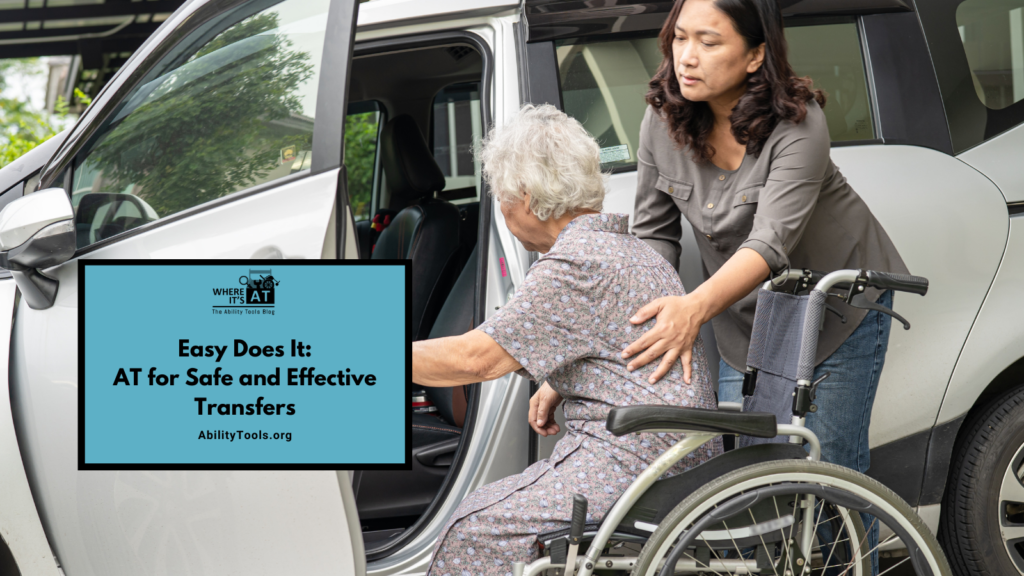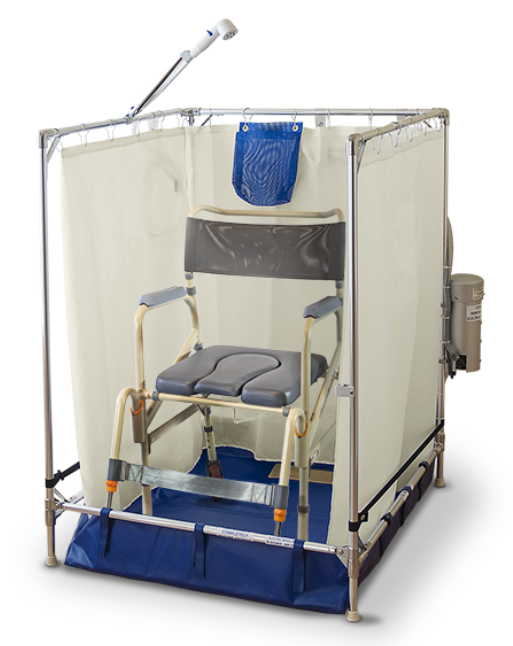Assistive technology plays a crucial role in making patient transfers safer and more independent for people with disabilities. Transferring patients, such as moving from a bed to a wheelchair, is more than just physical support; it’s about enhancing safety and fostering independence. Let’s explore the various assistive technologies that make this possible and see how they’re changing lives in both clinical and home environments.

Understanding Different Types of Transfers
Bed-to-Chair Transfers:
Bed-to-chair transfers involve caregivers assisting individuals from their beds to wheelchairs, particularly those who cannot bear weight on their legs. Transfer boards like the Beasy Glyder Transfer Board, and patient lifts like the Hoyer Advance E-Portable Patient Lift, Prism P-440 Portable Ceiling Lift, and gait belts, are essential for those with limited mobility. Sliding sheets, bed rails, and adjustable-height beds can be additional worthwhile investments to consider.
Chair to Toilet Transfers:
An individual with limited mobility may use a transfer bench like the DMI Tub Transfer Bench or the padded transfer bench with commode opening to safely move from a wheelchair to a toilet. The process involves sliding across the bench and minimizing physical strain. It’s a good idea to look for models that include a removable commode or cut-out seat for added convenience. Toilet lift chairs, like the EZ-TILT Toilet Incline Lift, and grab bars can also be installed near the toilet. Other great options that do not require permanent modifications to a bathroom can also include Drive Elevated Raised Toilet Seat with Removable Padded Arms, and toilet safety rails.
Bath Transfers:
Transferring into a bathtub can be challenging due to the slippery surface. Non-slip mats can be used for a safer transition, along with a transfer bench like the Drive Medical Splash Defense Transfer Bench with Curtain Guard Protection which is designed to allow the shower curtain to properly close while in use for added privacy. Specialty shower chairs, like the TubBuddy Tilt Bathtub Transfer System, are equipped with a tilt option that allows the caregiver to relieve pressure on the patient while simultaneously making it easier to bathe the patient. EZ-BATHE Inflatable Bathtub allows individuals to enjoy a bath without leaving their bed. The individual rolls onto a vinyl tub, which is then inflated around them using the included wet-dry vacuum. A portable shower system photographed below, like the S2000 Standard Shower Bundle with SB7E Shower Chair may offer some portability and convenience to be set up anywhere you have access to a faucet.
Vehicle Transfers:
Moving from a wheelchair into a car can often involve a transfer board or a swivel seat cushion to reduce friction and make the transfer smoother. Car transfer aids like the HandyBar Car Transfer Handle, or the car safety grab handle can be used to accomplish this. Additionally, individuals with disabilities have many options to modify their vehicles, like installing power transfer seats. Check out Mobility Works for additional options for both passengers and drivers.
Factors influencing the choice of transfer methods and devices
Several factors play a crucial role in determining the most suitable transfer methods and devices.
Physical Ability of the User:
Assessing the user’s strength, balance, endurance, and range of motion is crucial. For example, a Hoyer lift and sling might be necessary for those with very limited mobility, whereas a wooden transfer board could suffice for someone with greater upper-body strength.
Size and Weight of the User:
The physical dimensions and weight of the person being transferred affect the choice of device. Heavier individuals may require a more robust lift system with a higher weight capacity.
Caregiver availability and strength:
The physical ability of the caregiver to assist with transfers is important. Devices that reduce physical strain, like Sit to Stand, can be crucial in preventing caregiver injuries.
Environment:
Space constraints, the presence of stairs, and bathroom layout can influence the choice of devices. For instance, a compact and foldable transfer bench might be chosen for small bathrooms. In a living room, a power lift recliner and transfer pole might be ideal for individuals who have the space to accommodate as well as the physical ability to move with some independence.
Frequency of transfer:
The frequency of transfers throughout the day can dictate the need for more efficient or easy-to-use devices. Frequent transfers might justify the investment in a split seat adjustable transfer lift chair for ease and speed.
Cost and Funding:
Financial considerations often influence the choice of transfer aids. More expensive devices, like overhead lifts, stair lifts, and powered stair climbers may require funding assistance.
User preference and comfort:
Personal comfort and preference should not be overlooked. Some individuals might prefer certain types of equipment based on past experiences or comfort level.
Safety Concerns:
The primary concern is always safety! The chosen method and device must ensure a secure and injury-free transfer.
| Assistive Technology (AT) | Physical Ability of the User | Size and Weight of the User | Caregiver Availability and Strength | Environment | Frequency of Transfer | Cost and Funding |
|---|---|---|---|---|---|---|
| Adjustable-Height Bed | Moderate to good | All sizes | Not required | Moderate | High | High |
| Bath Lift | Limited | From small to large | Not required | Small | Medium | Medium to High |
| Bed Rail | Moderate | All sizes | Not required | Any | High | Low to Medium |
| Ceiling Lift | Very limited | All sizes | Optional | Any (with installation) | High | High |
| Floor-to-Ceiling Pole | Moderate to good | All sizes | Not required | Moderate | High | Medium |
| Gait Belt | Moderate | All sizes | Required | Any | High | Low |
| Hoyer Lift (Electric) | Very limited | All sizes | Required | Spacious | High | High |
| Hoyer Lift (Manual) | Very limited | All sizes | Required | Spacious | Medium to High | Medium |
| Leg Lifter | Moderate upper body | All sizes | Not required | Any | Medium | Low |
| Mobility Scooter with Lift | Moderate to good | From small to large | Not required | Outdoor/Indoor with space | Medium to High | High |
| Patient Lift Sling | Very limited | All sizes | Required | Spacious | High | Medium |
| Pool Lift | Limited | All sizes | Optional | Outdoor/Swim Area | Low to Medium | High |
| Portable Floor Lift | Very limited | All sizes | Required | Spacious | Medium | High |
| Powered Transfer Seat (Vehicle) | Moderate to good | From small to large | Not required | Vehicle | Medium | High |
| Reclining Shower Chair | Limited | From small to large | Optional (depending on style) | Small | Medium | Medium to High |
| Sit-to-Stand Lift | Limited | All sizes | Required | Moderate | High | High |
| Sliding Sheets | Limited to moderate | All sizes | Required | Any | High | Low to Medium |
| Stair Lift | Limited to moderate | From small to large | Not required | Any with stairs | Medium to High | High |
| Swivel Cushion | Moderate | Small to medium | Not required | Any | Low to Medium | Low |
| Toilet Incline Lift | Moderate | From small to large | Optional | Any | Medium to High | High |
| Transfer Bench | Moderate | All sizes | Not required | Small | Medium | Medium |
| Transfer Board | Moderate to good upper body | Small to medium | Not required | Any | Medium | Low |
| Transfer Pole | Moderate to good | All sizes | Not required | Any | High | Medium |
| Turntable (Rotating Disk) | Moderate | Small to medium | Optional | Any | Medium | Low |
| Walking Frame with Seat (Rollator) | Moderate | Small to medium | Not required | Moderate | High | Low to Medium |
From simple aids to sophisticated devices, each tool is a step towards more independence and dignity for individuals with disabilities. Here at Ability Tools, we know the right tool doesn’t just assist with a single transfer; it positively impacts lives daily.





